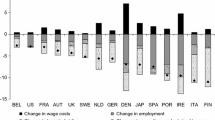Abstract
Unemployment in the 1930s is a central issue in macroeconomics, and it is the persistence of high unemployment that makes the Great Depression unique in American history. Why were rates of unemployment so high for so long? How can one reconcile persistent unemployment with the rise in real wages throughout much of the decade?
I am grateful to Martin Baily, Barry Eichengreen, Stanley Engerman, David Feldman, Claudia Goldin, Tim Hatton, Takao Kato, Tom Michl, Mark Rockel, Charles Trout, John Wallis, and participants at the Conference on Interwar Unemployment in International Perspective for helpful comments. Errors are my own.
Access this chapter
Tax calculation will be finalised at checkout
Purchases are for personal use only
Preview
Unable to display preview. Download preview PDF.
Similar content being viewed by others
References
Amemiya, T. (1981), “Qualitative Response Models: A Survey”, Journal of Economic Literature 4, pp. 1483–536 (December).
Baily, M.N. (1983), “The Labor Market in the 1930s”, in J. Tobin (ed.), Macroeconomics, Prices and Quantities: Essays in Honor of Arthur Okun, Washington, DC: Brookings Institution.
Bakke, E.W. (1940), The Unemployed Worker, New Haven: Yale University Press.
Bernanke, B. (1986), “Employment, Hours, and Earnings in the Depression: An Analysis of Eight Manufacturing Industries”, American Economic Review 76, pp. 82–109 (March).
Blanchard, O. and Summers, L. (1986), “Hysteresis and the European Unemployment Problem”, Cambridge, Mass.: National Bureau of Economic Research, Working Paper no. 1950.
Darby, M. (1976), “Three and a Half Million US Employees Have Been Mislaid: Or, An Explanation of Unemployment, 1934–1941”, Journal of Political Economy 84, pp. 1–16 (February).
Feldstein, M. (1976), “Temporary Layoffs in the Theory of Unemployment”, Journal of Political Economy 84, pp. 937–58 (October).
Howard, D. (1943), The WPA and Federal Relief Policy, New York: Russell Sage Foundation.
Jenkins, R. (1983), Procedural History of the 1940 Census of Population and Housing, Madison: Center for Demography and Ecology, University of Wisconsin.
Katz, L. (1986), “Layoffs, Recall, and the Duration of Unemployment”, Cambridge, Mass.: National Bureau of Economic Research, Working Paper no. 1825.
Kesselman, J. and Savin, N.E. (1978), “Three and a Half Million Workers Were Never Lost”, Economic Inquiry 16, pp. 186–191 (April).
Keyssar, A. (1986), Out of Work: The First Century of Unemployment in Massachusetts, Cambridge: Cambridge University Press.
Lucas, R. and Rapping, L. (1972), “Unemployment in the Great Depression: Is There a Full Explanation?”, Journal of Political Economy 80, pp. 186–191 (January/February).
Rao, C. (1973), Linear Statistical Inference and Its Applications, New York: John Wiley.
Salant, S. (1977), “Search Theory and Duration Data: A Theory of Sorts”, Quarterly Journal of Economics 91, pp. 39–58 (January).
Sinclair, P. (1987), Unemployment: Economic Theory and Evidence, Oxford: Basil Blackwell.
Topel, R. (1983), “On Layoffs and Unemployment Insurance”, American Economic Review 83, pp. 541–559 (September).
US Bureau of the Census (1983), Census of Population, 1940: Public Use Micro-data Sample, Washington, DC: US Bureau of the Census.
US Federal Works Agency (1946), Final Report of the WPA Program, 1935–43, Washington, DC: US Government Printing Office.
Wallis, J. (1986), “Employment in the Great Depression”, mimeo, College Park, University of Maryland.
Woytinsky, W.S. (1943), Three Aspects of Labor Dynamics, Washington, DC: Social Science Research Council.
Editor information
Editors and Affiliations
Rights and permissions
Copyright information
© 1988 Kluwer Academic Publishers
About this chapter
Cite this chapter
Margo, R. (1988). Interwar Unemployment in the United States: Evidence from the 1940 Census Sample. In: Eichengreen, B., Hatton, T.J. (eds) Interwar Unemployment in International Perspective. NATO ASI Series, vol 43. Springer, Dordrecht. https://doi.org/10.1007/978-94-009-2796-4_9
Download citation
DOI: https://doi.org/10.1007/978-94-009-2796-4_9
Publisher Name: Springer, Dordrecht
Print ISBN: 978-94-010-7758-3
Online ISBN: 978-94-009-2796-4
eBook Packages: Springer Book Archive




